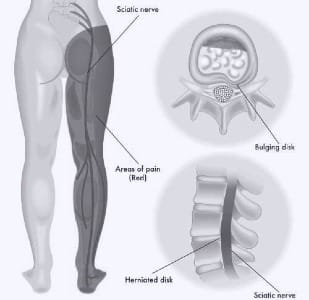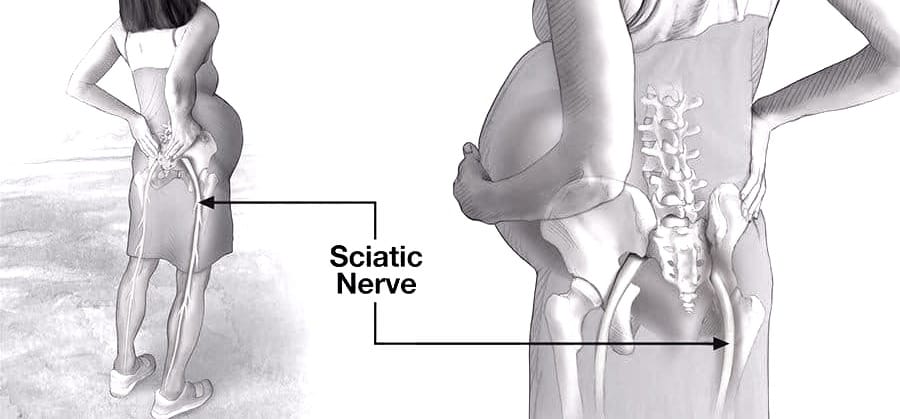Top Causes of Sciatica: What Triggers Sciatic Nerve Pain?
What Triggers Sciatica: Lifestyle factors like poor posture and pregnancy can contribute, emphasizing the need to understand the triggers for prevention and management.

Sciatica, a condition that manifests as pain radiating along the sciatic nerve, is often a result of nerve compression. Understanding the triggers behind sciatica is crucial for both prevention and effective management. In this article, we'll explore the primary causes of sciatica, emphasizing the intricate details of how these triggers lead to this often debilitating condition.
In this article, we will explain:
- Understanding sciatica.
- What Triggers Sciatica & Common Triggers.
- How to seek relief.
Understanding Sciatica:
Sciatica is characterized by pain, tingling, or numbness that travels along the path of the sciatic nerve, typically extending from the lower back through the hips and down each leg. The sciatic nerve, being the longest nerve in the body, can be susceptible to various factors that cause compression or irritation.
Common Triggers
- Herniated Disc
A herniated disc occurs when the soft inner material of a spinal disc leaks out through a tear in the tougher outer layer, pressing on the nearby nerves, including the sciatic nerve. This can be a result of physical trauma or repetitive strain.
Effects: The pressure on the nerve can cause pain, inflammation, and discomfort along the sciatic pathway.
- Bone Spurs (Osteophytes)
Overgrowth of bone, known as bone spurs, can develop on the spinal bones due to aging or conditions like osteoarthritis. These spurs may encroach upon the space reserved for nerves, including the sciatic nerve.
Effects: Bone spurs can cause irritation and compression of the sciatic nerve, leading to sciatic pain.
- Tumors
While less common, tumors can grow near or on the spine, exerting pressure on the sciatic nerve.
Effects: The presence of a tumor can disrupt the normal functioning of the nerve, causing pain and other symptoms associated with sciatica.
- Trauma-Induced Sciatica
Trauma-induced sciatica occurs when physical injuries or accidents impact the sciatic nerve. Imagine the sciatic nerve as a delicate communication line in the body.
Injuries such as falls, car accidents, or other trauma can directly harm this nerve, leading to pain, tingling, or numbness. It's like a disruption in the body's messaging system caused by external forces.
Recognizing the connection between trauma and sciatica helps individuals understand the source of their discomfort, guiding them toward seeking appropriate medical attention and tailored treatments to alleviate the effects of the injury on the sciatic nerve.
- Obesity on Sciatica
Carrying excess body weight can contribute to the spinal changes that trigger sciatica. The additional weight can increase the burden on the spine and lead to conditions like herniated discs or spinal stenosis, which in turn can cause or trigger sciatica on its own.

Obesity does not cause sciatica but it can make it worse or contribute to its development.
- Pregnancy
During pregnancy, the sciatic nerve can be influenced by a type of spinal compression. The body releases a hormone known as relaxin to facilitate the relaxation of ligaments and prepare the pelvis for childbirth.

While this hormonal response is a natural part of pregnancy, it can result in loose ligaments and a shifting center of gravity due to the growing uterus. These changes may lead to the pinching of the sciatic nerve, causing shooting pains down the legs.
- Occupational Hazards and Sciatica
Occupational hazards can contribute to or trigger sciatica due to prolonged sitting, especially with poor posture, or jobs that require heavy lifting and repetitive movements that can strain the spine and compress the sciatic nerve.
Think of it like the body enduring daily challenges at work, leading to pressure on the nerve. Jobs that involve whole-body vibrations, such as driving heavy machinery, can also play a role.
Recognizing these workplace factors helps individuals take preventive measures, like ergonomic adjustments or regular breaks, to reduce the risk of developing sciatica and maintain a healthier and more comfortable work environment.
Diabetes and Sciatica
The relationship between diabetes and sciatica is complex, and while diabetes itself doesn't directly cause sciatica, it can contribute to conditions that may lead to sciatic nerve pain. Here's how diabetes may be linked to sciatica:

Nerve Damage (Neuropathy): Diabetes can lead to a condition called diabetic neuropathy, which involves nerve damage. Over time, high levels of blood sugar can injure the nerves, affecting their ability to transmit signals properly. Sciatic nerve pain can occur if the sciatic nerve is impacted by diabetic neuropathy.
- Inflammation: Diabetes is associated with chronic inflammation throughout the body. Inflammation can contribute to the compression of the sciatic nerve or exacerbate existing conditions that lead to sciatica.
- Metabolic Factors: People with diabetes often experience metabolic changes that may affect the health of the spinal discs. Changes in the structure of the discs can result in conditions like herniated discs, which can, in turn, lead to sciatica.
- Obesity: Obesity is a common risk factor for both diabetes and sciatica. Excess weight can put pressure on the spine, potentially leading to conditions that cause sciatic nerve compression.
It's essential to note that not every individual with diabetes will experience sciatica, and there can be multiple contributing factors. Moreover, managing diabetes effectively through lifestyle changes, medication, and regular monitoring can help reduce the risk of developing complications such as neuropathy.
If someone with diabetes is experiencing symptoms resembling sciatica, it's crucial to consult with a healthcare professional for a thorough evaluation. This allows for accurate diagnosis and the development of a tailored treatment plan that addresses both diabetes management and any associated sciatic nerve issues.
Seeking Relief
Understanding the triggers behind sciatica is the first step toward effective management. Seeking professional medical advice is crucial for accurate diagnosis and personalized treatment plans. Common approaches to managing sciatica include:
Pain Management
Over-the-counter or prescription medications to alleviate pain and inflammation. Natural remedies such as topical creams and oral supplements may help to reduce inflammation and promote healing.
Physical Therapy
Physical Therapy and ExerciseRegular exercise may help reduce the pain but consult a professional before starting any exercise to avoid injury or aggravating sciatica symptoms.
Targeted exercises to strengthen the back and improve flexibility. Improve physical activity levels and reduce the risk of falls, which can be a contributing factor to sciatica. Chiropractic CareChiropractic care can help reduce pain and inflammation and improve flexibility.
Invasive Procedures
In severe cases, procedures like epidural steroid injections or surgery may be considered. It's important to note that invasive procedures should be considered only after all other treatment and management options have been exhausted.
Key Takeaways
Sciatica is a complex condition with various triggers, all involving compression or irritation of the sciatic nerve. Identifying the specific cause is essential for tailoring an effective treatment plan. If you experience persistent sciatic pain or related symptoms, consult a healthcare professional to explore the most suitable options for your case. Early intervention and comprehensive care are key to finding relief and reclaiming a life free from sciatic discomfort.
Summary
Sciatica is a condition that can be triggered by various factors, including herniated discs, spinal stenosis, and piriformis syndrome. Obesity, pregnancy, trauma, certain occupations, diabetes, and lifestyle choices can also increase the risk of developing sciatica. Preventative measures such as maintaining a healthy weight, exercising regularly, and practicing good posture can help reduce the likelihood of experiencing sciatica. When symptoms do arise, it's crucial to consult a healthcare professional for appropriate treatment.
FAQ Section
Q: What Triggers Sciatica?
Answer: Sciatica is often triggered by compression or irritation of the sciatic nerve, the longest nerve in the body. Common causes include herniated discs, bone spurs, or narrowing of the spine (spinal stenosis). Other factors that can contribute to sciatica include obesity, pregnancy, trauma, certain occupations, diabetes, and lifestyle choices.
Injuries, such as fractures or trauma to the pelvic region, can also lead to sciatic nerve compression. Additionally, muscle spasms, tumors, or infections near the sciatic nerve can contribute to the onset of sciatica.
Q: Can Poor Posture Cause Sciatica?
Answer: Yes, poor posture is a common factor contributing to sciatica. Prolonged periods of sitting, especially with improper posture, can lead to increased pressure on the lumbar spine and sciatic nerve.
Slouching or sitting on a wallet, for example, may compress the nerve over time. Maintaining good posture, taking breaks to stretch, and using ergonomic seating can help prevent sciatica triggered by poor posture.
Q: Does Pregnancy Contribute to Sciatica?
Answer: Pregnancy is a frequent trigger for sciatica due to the increased pressure on the sciatic nerve caused by the growing uterus. The weight of the baby and hormonal changes can lead to inflammation and compression of the nerve.
Sciatica during pregnancy is often temporary, but exercises, proper body mechanics, and prenatal care can help manage symptoms. If persistent, consulting with a healthcare provider is crucial for tailored guidance and relief.
